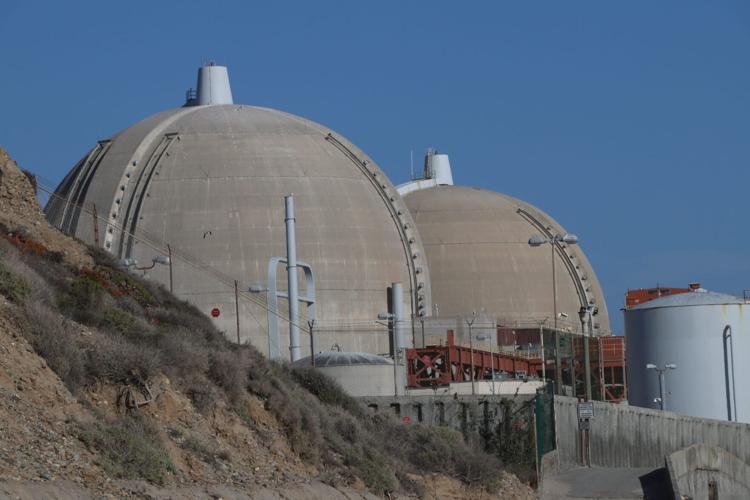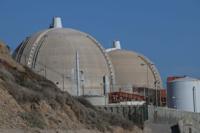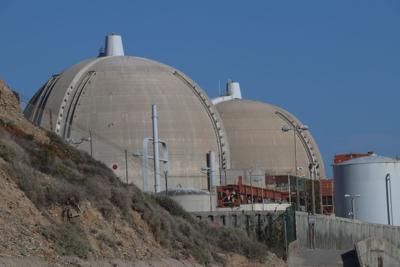SoCal Edison Lays Out Potential Plans, Alternatives for Relocating Spent Fuel
By Shawn Raymundo
Fifteen years ago, San Clemente Times spoke with the head of the state’s Department of Homeland Security to talk safety at the San Onofre power plant amid fears of potential terrorist attacks in the wake of 9/11.
In the time since first publishing that cover story, the San Onofre Nuclear Generating Station went from providing electricity to millions of the region’s homes, to shutting down in 2012 following the discovery of a radioactive leak in what was a new steam generator.
While safety remains at the forefront of discussions related to SONGS, the focus has largely pivoted to the long-term storage of its nuclear waste off the coast, as well as the ongoing uncertainty of whether the U.S. will site a permanent repository for the nation’s spent fuel—efforts that industry experts estimate could take decades.
Until such time a repository or off-site storage is identified, Southern California Edison, the majority owner of the plant, is responsible for storing its 3.55 million pounds of nuclear waste on-site.
Doug Bauder, SCE vice president and chief nuclear officer, stressed that while keeping the waste stored safely is “at the top of mind” for the company, the name of the game at this stage in the ongoing decommissioning process is readiness.
“We want to be ready for moving the fuel when it’s time for pickup,” Bauder said during last week’s Community Engagement Panel meeting, which largely focused on detailing the company’s new blueprint and strategies for removing and relocating the decommissioned plant’s spent nuclear fuel.
“As we outlined in the plan, it could take 10 years or more for that entire activity to take place once a facility is available,” Bauder noted of the steps and length of time it’ll likely take to transfer the fuel. “But the bottom line is we want to be ready.”
LOOKING AHEAD
Edison, along with minority co-owners San Diego Gas & Electric and the cities of Anaheim and Riverside, unveiled last week the three-volume series of plans—an Action Plan, Strategic Plan and Conceptual Transportation Plan.
Those plans, which were developed in consultation with the firm North Wind, Inc., is a broad framework of alternatives and potential scenarios related to the relocation of the plant’s waste. It also recognizes the administrative and legislative actions needed to revive a national nuclear waste management program.
According to SCE, the Action Plan covers the company’s legislative advocacy efforts to implore lawmakers to draft policies that would spur solutions in getting an off-site storage facility established for spent fuel.
Under the Conceptual Transportation Plan, SCE outlines the steps it will need to take in order to get the waste shipped from the plant to such a repository.
“We anticipate that any large-scale shipment of nuclear fuel can be expected to draw significant public interest and concern,” said Joe Hezir, a North Wind representative. “We describe (in the plan) how the spent fuel would be prepared and shipped with various layers of protection for both the canisters and transportation casks.”
With its Strategic Plan, Edison considered multiple alternatives in terms of removing the fuel, assessing certain aspects such as costs, timelines and challenges of each scenario, “while making clear the challenges and needed actions for those alternatives to be realized.”
“(The plan) recognizes the importance of more near-term solutions, such as consolidated interim storage, as a companion to a consent-based federal permanent disposal program,” Edison said in its announcement.
In an emailed statement to SC Times on Tuesday, March 22, Surfrider Foundation, the San Clemente-based environmental nonprofit group, expressed appreciation for North Wind’s report and advocacy for getting an off-site facility constructed that’s also consent-based—meaning it would require the approval of the local community, government and stakeholders.
“We stress to the public that this issue needs a federal commitment for meaningful action to take place,” the advocacy group said in its statement, adding: “Surfrider will continue to execute our campaign toward the goal of protecting our coast.”
SETTLING LITIGATION
The release of the plans fulfills the terms of a 2017 settlement agreement with the advocacy group Citizens Oversight and San Diego resident Patricia Borchmann.
In November 2015, Borchmann and the nonprofit organization challenged the coastal development permit that the California Coastal Commission had granted Edison the month before so it could begin constructing its dry storage facility—the Independent Spent Fuel Storage Installation, or ISFSI.
The lawsuit, which sought to revoke the development permit, also asked a San Diego court to order the removal of the waste and have it stored at the Palo Verde Nuclear Generating Station, just outside of Phoenix, Arizona.
Under the terms of the settlement, Edison was required to assemble an Experts Team comprising industry officials who would be tasked with advising the company on relocation methods. It also stipulated the development of the conceptual and strategic plans to guide Edison’s efforts to remove the waste and store it, when possible, at an off-site facility.
The settlement also mandated that SCE make a formal request to Arizona Public Services, the owners of the Palo Verde plant, asking to expand its own ISFSI to store the waste from SONGS.
“The Palo Verde owners made it very clear that they are opposed,” Hezir explained during the March 18 CEP meeting.
Over the years, Edison has faced multiple legal challenges questioning its storage of the waste while imploring the courts to halt the transfer of the plant’s spent fuel into the ISFSI.
This June, a lawsuit that the Samuel Lawrence Foundation brought against the Coastal Commission and Edison is expected to go before a Los Angeles County Superior Court judge. The Foundation is looking to overturn the commission’s October 2019 approval for Edison to begin dismantling the facilities at the plant.
The CCC, the lawsuit alleges, violated its own objectives and standards by approving the development permit—which the Foundation believes will have an impact on coastal resources such as San Onofre State Beach, the campground, Camp Pendleton and the terrestrial ecology.
“The project maximizes risks to life and property and threatens geologic stability along the bluffs,” the lawsuit states, adding: “The Commission has also failed to address or completely address seismic and tsunami risks.”
The Coastal Commission had noted in its report for that October 2019 meeting that SCE’s plans to remove the infrastructure would leave “significant amounts of foundation, footings, and other existing material in place,” potentially leaving the coastal environment and community vulnerable to safety risk.
To address those concerns, the Coastal Commission imposed conditions, including one requiring Edison to provide annual progress reports of the project every June, as well as mandating the development and submission of a Spill Prevention Control and Countermeasure Plan to the commission for approval prior to the start of the project.
Since shutting down for good in 2013, Edison has been in the process of decommissioning the plant, which currently sits on land owned by the U.S. Navy. Per the Nuclear Regulatory Commission, Edison is on a 60-year clock to complete the decommissioning.
The roughly eight-year plan of dismantling much of the structures, including the containment domes, got underway in earnest last year, while Edison finished transferring its last bit of nuclear waste into canisters, downloading them into the ISFSI.
THE ALTERNATIVES
While outlining Edison’s fuel-removal plans, Hezir said the alternatives hinged on when and how the federal government takes title of the plant’s waste.
“And if they don’t take title, what is available to SONGS co-owners to move this fuel to a non-federal storage facility, some other facility within the site or some form of multi-utility or variant alternative?” Hezir said.
He explained that one of the critical takeaways was that the possibility of transferring the spent fuel from SONGS to an interim consolidated off-site storage facility is likely to occur decades before a permanent repository program is set up.
“It’ll be much closer in alignment with the current SONGS decommissioning plan and schedule,” Hezir said. “I’m not saying we don’t need a permanent repository; it just says that the time sequencing, moving to an off-site storage facility, is likely to move the fuel much quicker.”
Potential commercial interim storage sites in New Mexico and Texas are currently going through the application and siting process. Both, Hezir said, are currently on track to receive licenses this year, but he noted there has been significant pushback from state governments.
Hezir also touched on the $20 million in federal money that Congress allocated to the Department of Energy this fiscal year for the creation of a consolidated storage facility. However, he noted, DOE is essentially “starting from scratch, so there would be significant implementation uncertainties related to siting and licensing.”
“It’s hard to put a specific figure on it, but we’re looking at, at least 10 years to site and license and build a facility using a consent-based process,” he said, noting the caveat that “not all spent fuel is going to be moved overnight. That process, particularly for a large-scale facility that’s going to be taking fuel from several locations, could take another 10 years to completely clear the SONGS site of all the spent fuel.”
Prior to 2010, when the Obama administration cut funding to the project, Yucca Mountain in Nevada had initially been identified as a permanent repository under the Nuclear Waste Policy Act of 1982.
“Yucca Mountain,” Hezier said, “has essentially been deconstructed.”
Hezir said a more viable alternative, which he referred to as a hybrid plan, would be the development of a private consolidated facility, such as the ones being considered in New Mexico and Texas, in tandem with a federal geological repository.
“Some form of a hybrid solution may be the best way to marry the work that’s been done to date,” he said, later explaining that getting the federal government to begin the process of siting a permanent facility could give reassurances to host communities of prospective interim sites.
“Getting to a permanent geologic repository is absolutely essential,” he said. “While we focus in this strategic plan on interim facilities, making progress on a repository is going to be critical to also ensuring the host community that any storage facility is truly a temporary storage facility.”
OFF-SITE STORAGE
As to potentially sharing space with other utility companies, as had been strongly suggested with the plant in Palo Verde, Hezir said there is an attractiveness to the idea, as amending permits for an existing ISFSI is easier than obtaining another one for a new facility.
However, he noted, “No other party has stepped forward with a willingness for such an agreement.”
Another option, he mentioned, was an idea to relocate Edison’s ISFSI somewhere else nearby, such as other land on Camp Pendleton. That plan, he said, was found to be costly and lengthy. Furthermore, Camp Pendleton reportedly told Edison that moving it to a different location on the base “would be inconsistent with its national mission of training exercises.”
According to Hezir, by 2025, California will become the largest holder of spent nuclear fuel, as the last remaining nuclear power plant, the Diablo Canyon plant near San Luis Obispo, is slated to shut down.
“We have three separate spent nuclear storage facilities that are along the California coastline, so we think this would create a commonality of interest, particularly when we talk about coalition action to move forward on a national program,” Hezir said.
STAKEHOLDERS ASSEMBLE
As part of Edison’s unveiling of the plans last week, it also announced the formation of a local stakeholder group, Action for Spent Fuel Solutions Now, charged with urging Congressional lawmakers to develop solutions to store the nation’s nuclear waste at off-site or permanent facilities.
“Over time, groups and organizations have called on the federal government to deliver a solution, and yet today, we stand with 123 canisters of nuclear fuel on our coastline,” Orange County Board Supervisor Lisa Bartlett said during the meeting.
“We know it’s unacceptable,” said Bartlett, whose district primarily represents South County cities, including San Clemente. “Residents are concerned, businesses are concerned, the active military base is concerned, and we really need to get things moving in the right direction.”
Bartlett will co-chair the new coalition alongside San Diego County Board Supervisor Jim Desmond. The group, which lists the SONGS operators as founding members, also includes several local government officials—one is San Clemente Councilmember Chris Duncan—as well as environmental and business groups.
Noting the significant amount of time it will take to relocate the waste, Bartlett said the group’s message is “very succinct and very clear: the federal government needs to take action, they need to step up and do what’s right, and they need to start doing that right now.”

SR_1
Shawn Raymundo
Shawn Raymundo is the city editor for the San Clemente Times. He graduated from Arizona State University with a bachelor’s degree in Global Studies. Before joining Picket Fence Media, he worked as the government accountability reporter for the Pacific Daily News in the U.S. territory of Guam. Follow him on Twitter @ShawnzyTsunami and follow San Clemente Times @SCTimesNews.




